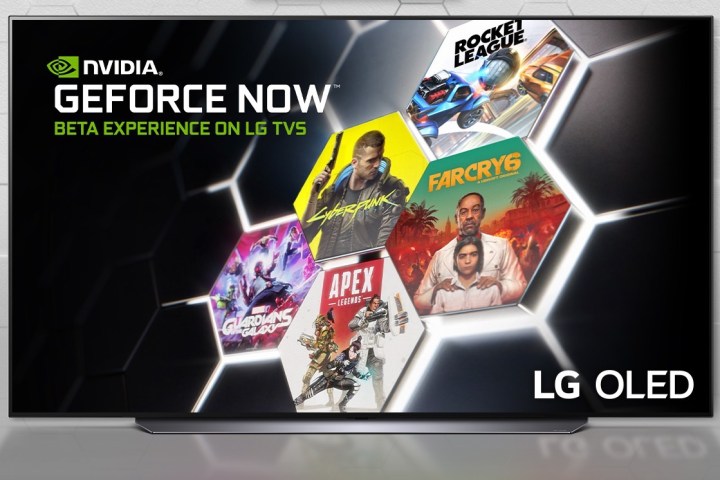LG has announced that it is the first smart TV maker to debut a native app for Nvidia’s GeForce Now online streaming gaming platform. The GeForce Now app will be available as a beta test on select 2021 TVs, including 4K OLED, QNED mini-LED, and NanoCell TV models in 80 markets globally. LG says the full list of compatible TVs will be released at a later date.
With the GeForce Now app installed, users will have access to 35 free-to-play games if they own a compatible controller, with no additional hardware required. Games include Rocket League, Destiny 2, Marvel’s Guardians of the Galaxy, and the Crysis Remastered Trilogy. Games can be played at up to 1080p resolution and 60 frames per second, though there has been some recent controversy over this as Nvidia has admitted to capping some games at lower frame rates. (Digital Trends has put together a list of the best GeForce Now games.)
There are three tiers to the GeForce Now service: Free, Priority ($50 per month), and the recently announced RTX 3080 ($100 per month) that lets gamers experience 1440p resolution at 120Hz. As shortages of high-end graphics cards has continued, this new tier is something of a stopgap until gamers can once again upgrade their rigs. LG hasn’t indicated whether its GeForce Now app will support the RTX 3080 tier.

GeForce Now Priority members get access to ray tracing and A.I. technologies streaming from Nvidia RTX-powered servers in data centers worldwide. One of the benefits of the GeForce Now service is that games can be started on one device an then continued on another. GeForce Now is currently available on Nvidia Shield TV, Windows PCs, MacOS, Chrome OS, Android, and the Safari browser for iPhone and iPad.
“Partnering with Nvidia to bring GeForce Now to LG TV owners is a sign of our commitment to deliver the best gaming experience on LG TVs running WebOS,” said Lee Sang-woo, senior vice president of corporate business strategy at LG Electronics Home Entertainment Company.
LG has a long-standing relationship with Nvidia. LG’s OLED TVs were the first to be compatible with Nvidia’s G-Sync variable refresh rate (VRR) technology, making the TVs among the best large-size displays for PC and console gaming.



